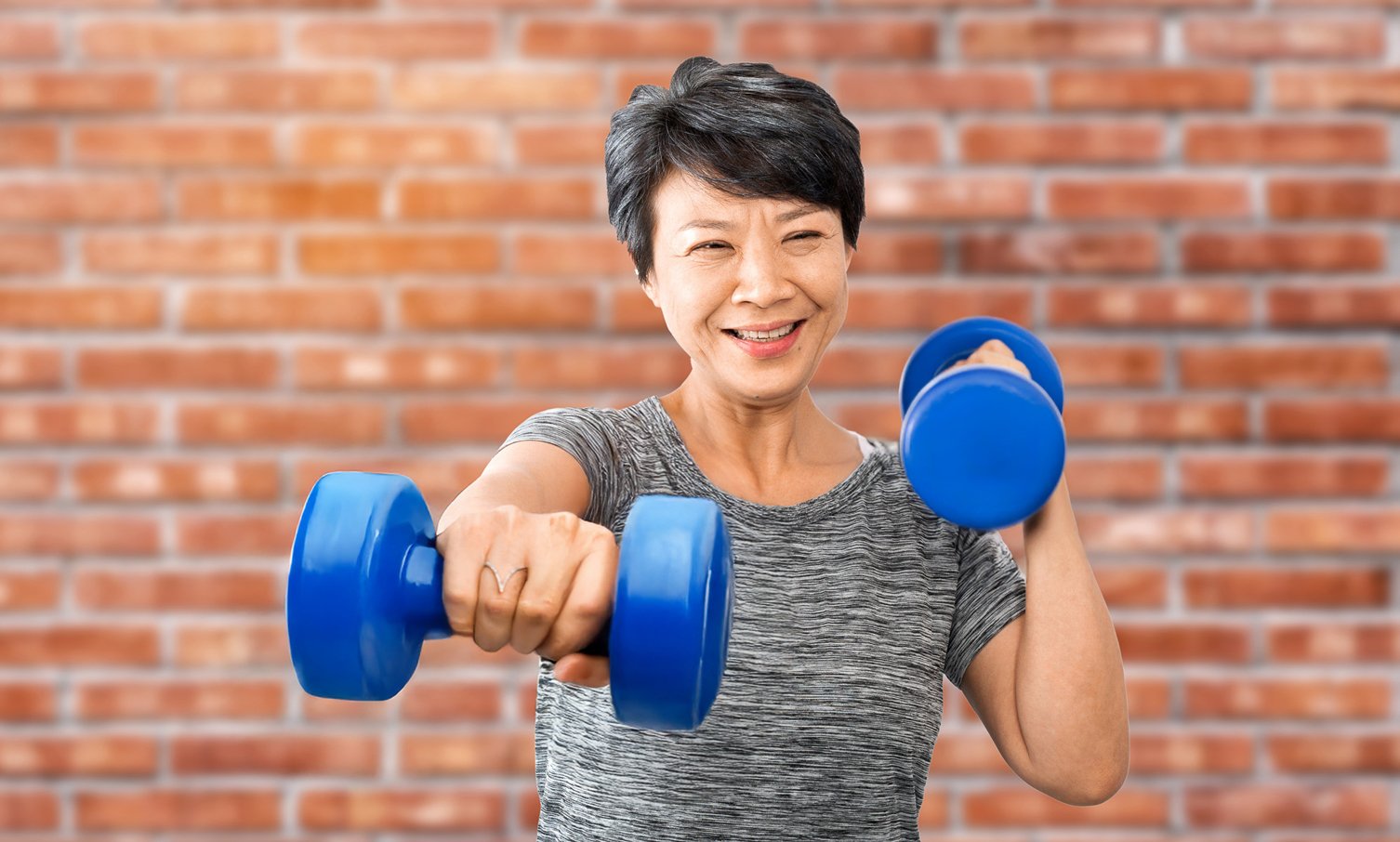Move It or Lose It: What Muscles Really Do in Menopause
Reading time 8 min

Reading time 8 min

We often discuss exercise and its numerous benefits during the menopause transition, but what is really happening inside our bodies when we move? One major concern many overlook is muscle loss during menopause, which can quietly impact strength, energy, and overall health. I’ve always been fascinated by how exercise can act like medicine—no pills required. Its ability to influence nearly every system in our body is nothing short of extraordinary.
What happens to your muscles during menopause?
During menopause, declining estrogen levels cause muscle mass and strength to decrease—a condition known as sarcopenia. This leads to reduced metabolism, higher risk of injury, and decreased energy. Fortunately, resistance training can reverse much of this loss.
Muscle isn’t just about looking toned or feeling strong—it’s a living, dynamic tissue made of cells that contract and generate force. It is the largest organ in our body (yes it is an organ) making up 50% of our body mass. These contractions allow us to move, lift, twist, and stabilize1, 2.
Muscle comes in three main types:
1. Skeletal Muscle
This is what you train when you lift weights or go for a run. It’s attached to bones and is responsible for voluntary movements. This is the muscle we care most about when we talk about strength, mobility, and posture. Within skeletal muscle, there are two main fiber types3:
2. Cardiac Muscle
Found only in the heart, this muscle works non-stop to pump blood throughout your body.
3. Smooth Muscle
You don’t see or feel this one, but it’s everywhere—lining your blood vessels, digestive tract, and uterus. It controls things like digestion and blood pressure without any conscious effort from you.
Compared to men, women naturally have a slightly higher proportion of slow-twitch (Type I) fibers, making them generally more fatigue-resistant and better suited to endurance activities4.

Your muscles adapt remarkably to different types of exercise.
Resistance (Strength) Training
Strength training primarily activates Type II fibers, stimulating muscle growth (hypertrophy) and strength gains. Regular resistance exercise leads to increased muscle mass, strength, metabolism, and improved bone health5.
Aerobic (Endurance) Training
Activities like walking, running, cycling, and swimming enhance Type I fibers, improving muscle endurance, heart health, and energy efficiency. Aerobic training also increases the number of mitochondria (the energy factories within cells) boosting your overall energy, endurance, and improving your VO2max, which reflects aerobic capacity6.
High-Intensity Interval Training (HIIT)
Combining aspects of aerobic and resistance training, HIIT rapidly improves muscle power, endurance, and overall metabolic health by repeatedly activating both fiber types intensely. HIIT workouts also significantly enhance VO2max7.
The drop in estrogen starting in perimenopause accelerates muscle loss, a process known as sarcopenia. You might notice decreased strength, increased fatigue, and changes in body shape as muscle mass diminishes.
This muscle loss isn’t just cosmetic—it reduces metabolism, strength, and bone support, increasing your risk of injuries, falls, and chronic health conditions like osteoporosis and metabolic diseases8.
Muscle Mass Loss
Decreased estrogen is associated with significant decreases in lean body mass, lean muscle in the arms and leg, and the size of individual muscle areas.
Muscle Strength and Performance
After menopause, many women find that they’re not as strong as they used to be. Everyday things like opening a jar or getting out of a low chair feel harder. That’s because muscle strength and power decrease, especially if menopause comes early or is caused by surgery.
As estrogen decreases, your muscle’s ability to regenerate after exercise also declines, partly due to reduced activity of muscle stem cells (called satellite cells). This means recovery from workouts may feel longer, and building muscle can seem harder.
However, the good news is that your muscles still respond positively to exercise. Studies consistently show that resistance training effectively maintains and even increases muscle mass and strength during menopause. For example, a 2024 randomized controlled trial investigated a 12-week low-impact resistance training program in healthy perimenopausal and postmenopausal women who were not on hormone therapy.
The study found significant improvements in hip strength, balance, flexibility, muscle thickness, and lean mass across all menopause stages. It showed that even without estrogen therapy, muscles can still adapt and improve with the right kind of training9.
Exercise also helps preserve bone density, which is particularly important as bone loss accelerates after menopause. Regular physical activity boosts muscle health, supports bone density, improves metabolism, and reduces inflammation.
Tailored exercises specifically for menopause can significantly mitigate these changes, helping you maintain muscle mass and strength effectively.
Let’s break down a few commonly used terms you’ll see throughout our articles on exercise.
Endurance
Your muscle’s and cardiovascular system’s ability to sustain activity over time. Think walking a long distance without tiring.
Stability
The ability to control your body’s position and movement, especially important for balance and joint safety.
VO2max
A measure of your body’s maximum oxygen uptake during exercise. It reflects your aerobic fitness and endurance capacity.
Strength
The ability of your muscles to produce force—like lifting something heavy or climbing stairs.
Muscle Mass
The total amount of muscle in your body. More muscle mass generally means better metabolism and physical strength.

Muscle Power
How quickly you can generate force. It’s not just about strength but also speed—key for movements like jumping or rising from a chair.
Metabolism
The set of chemical processes your body uses to convert food into energy. More muscle typically means a higher resting metabolism (which means you burn more calories at rest!).
Energy Efficiency
How well your body converts fuel into movement. Improved efficiency means you use less energy for the same task, a benefit of regular training.
Hypertrophy
The biological process of muscle fiber growth in response to resistance training. This is how your muscles get stronger and visibly larger.
Recovery
The time your muscles and energy systems need to repair and adapt after exercise. This process takes longer during and after menopause.
Adaptation
The way your body adjusts to exercise over time—by building more muscle, improving cardiovascular capacity, and becoming more efficient. Regular variation in training helps maintain progress.
One day, I was sitting on the bathroom floor, and as I went to stand up, I realized something was off. My one knee hurt badly, and I had to grab the sink edge just to get up. I felt frustrated—and old.
A month later, during a ski trip, the instructor was teaching us how to fall safely. But when I tried to get up as he instructed, I couldn’t. My knees swelled like balloons that night. That was my rock bottom.
I knew something had to change. I signed up for a CrossFit class. Over time, I lost weight, gained strength, and nearly all the pain in my knees and back disappeared.
Now, I maintain my strength and mobility with resistance training three times a week at home and daily walks.
Sometimes I’m very lazy to exercise—I’ll be honest. I stare at my dumbbells or shoes and think, “Not today.” But I’ve learned to pause and remind myself what’s at stake.
This isn’t about chasing perfection. It’s about protecting my joints, keeping my back pain away, and giving my body what it truly needs to thrive. Exercise isn’t just something I check off a list—it’s what helps me feel more like myself. Just moving a little can change everything: mood, energy, sleep, strength, even how I feel in my own skin.
Understanding the biology of muscle during menopause is useful. By knowing how muscles work and respond to different exercises, you can choose activities that effectively counteract menopause-related muscle loss.
Tailored exercises specifically designed for menopause transition can effectively mitigate these changes, helping you maintain strength and muscle health.
Dr. Jūra Lašas
1.
Bonen, A. Muscles as molecular and metabolic machines. (2010) https://doi.org/10.1152/ajpendo.00245.2010
2.
Frontera, W. et al. Skeletal Muscle: A Brief Review of Structure and Function. (2014) https://doi.org/10.1007/s00223-014-9915-y
3.
Narici, M. et al. Muscle structural assembly and functional consequences. (2016) https://doi.org/10.1242/jeb.128017
4.
Nuzzo, J. Sex differences in skeletal muscle fiber types: A meta‐analysis. (2023) https://doi.org/10.1002/ca.24091
5.
Moro, T. et al. Resistance exercise training promotes fiber type-specific myonuclear adaptations in older adults. (2020) https://doi.org/10.1152/japplphysiol.00723.2019
6.
Lundberg, T. et al. The Effects of Concurrent Aerobic and Strength Training on Muscle Fiber Hypertrophy: A Systematic Review and Meta-Analysis. (2022) https://doi.org/10.1007/s40279-022-01688-x
7.
Torma, F. et al. High intensity interval training and molecular adaptive response of skeletal muscle. (2019) https://doi.org/10.1016/j.smhs.2019.08.003
8.
Pellegrino, A. et al. Mechanisms of Estrogen Influence on Skeletal Muscle: Mass, Regeneration, and Mitochondrial Function. (2022) https://doi.org/10.1007/s40279-022-01733-9
9.
Svensen, E. et al. A Novel Low-Impact Resistance Exercise Program Increases Strength and Balance in Females Irrespective of Menopause Status. (2024) https://doi.org/10.1249/MSS.0000000000003586